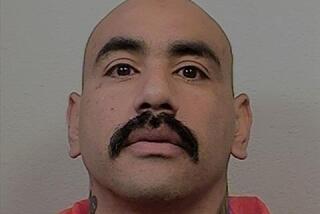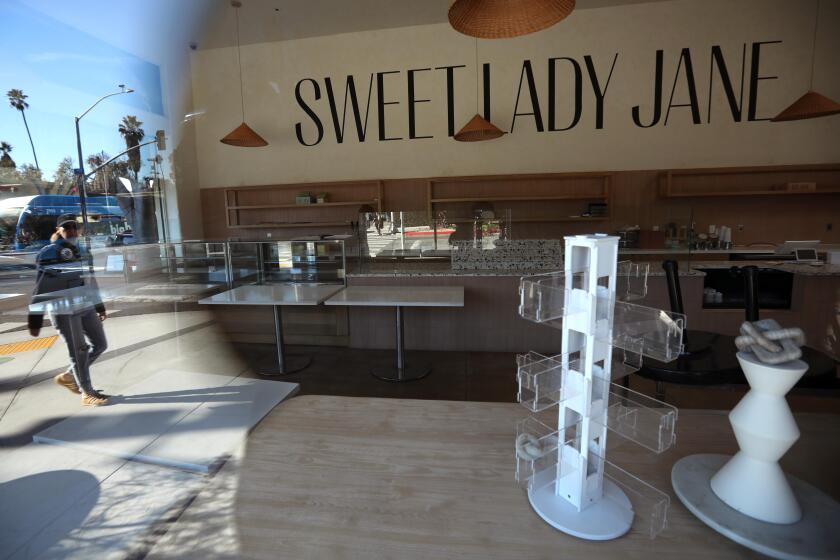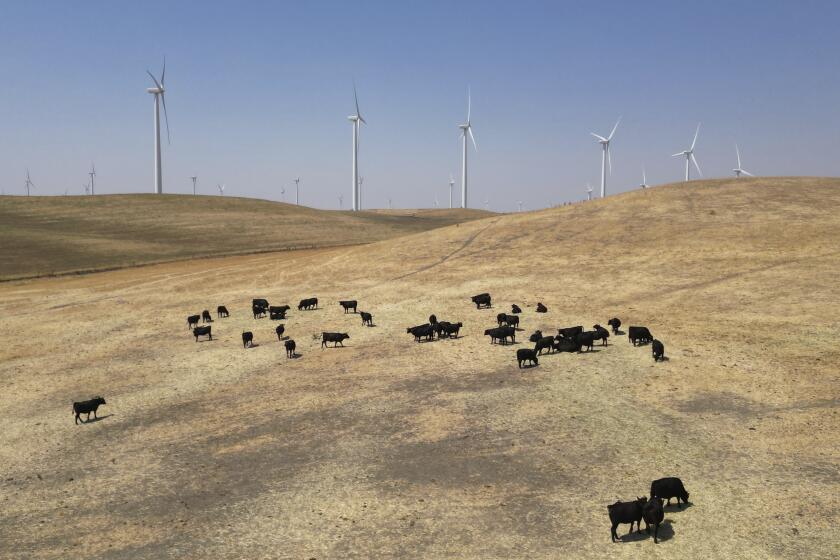‘Cotton Club’ Murders: Two Jakes and a Jill : Life mimics art in Depression-style saga of gangsters and violence set in Hollywood
International cocaine trafficking . . . contract murder plots . . . high-life courtesans, low-life prostitutes . . . chauffeurs, limos, porno, mob muscle and money.
Lots of money.
High-concept movie pitching?
No. Real-life trouble for the co-producer of “The Two Jakes” and former Hollywood Wunderkind Robert Evans.
While the fictional murder mystery is before the cameras these days, Evans is sweating testimony presented in a preliminary hearing in Los Angeles Municipal Court on June 21 that linked him to an all-too-real murder that took place six years ago, 25 miles north of the Santa Clarita Valley movie set.
Evans, the former chief of production at Paramount Pictures, was implicated in a murder-for-hire case that stemmed out of drug-dealing treachery surrounding the making of his last movie, “The Cotton Club.” In lonely, dead-end Caswell Canyon, just a short drive from what is today the “Two Jakes” set, hitmen pumped a dozen .22-caliber slugs into the head of a corpulent New York theatrical promoter on the night of Friday the 13th of May, 1983.
And a Los Angeles prosecutor believes Evans may have paid them to do it.
According to Deputy Dist. Atty. David Conn, Evans’ efforts to finance his ill-fated 1984 flop “The Cotton Club” led to the murder of 33-year-old Roy Radin. Though he has not been charged, Evans also has not been ruled out as a suspect. When Conn subpoenaed him to testify as a witness in the case seven weeks ago, Evans refused to incriminate himself and took the Fifth Amendment.
Through his attorney, Robert Shapiro, Evans maintains his innocence. Shapiro offered to let his client testify under a grant of immunity from prosecution last May 12, but Conn refused to grant it. As a result, Evans has maintained a steady silence about any role he may have had in the disappearance and death of Radin.
Radin, a 275-pound high school dropout from Long Island, came to California in the early ‘80s in an attempt to break into movies. Eventually, he managed the career of “Sanford and Son” TV star Demond Wilson and operated on the fringes of show business as the promoter of a traveling vaudeville show featuring chimps, jugglers and out-of-work celebrities such as Pat Paulsen.
But when he met Evans a few months before his death, Radin believed he was finally on the threshold of success. Cocaine, as it turned out, was the undoing of both of them.
In a tale that rivals any ever cranked out of a screenwriter’s fantasies, testimony in the so-called “Cotton Club” murder hearing currently under way in downtown Los Angeles links Evans to reputed Florida cocaine dealer Elayne (Lanie) Greenberger. Not only did the prim, silver-haired Greenberger keep Evans and Radin supplied with drugs, according to prosecutors, she also put them together in a vain attempt to raise $35 million to produce “The Cotton Club.”
Conn theorizes that Greenberger, 42, ordered three hitmen to kill Radin for two reasons: She believed he stole $200,000 in cash and 10 kilograms of cocaine from her Sherman Oaks home, and he tried to cut her out of the “Cotton Club” deal. According to testimony, she cried when Radin rejected her demand to share in the deal during a meeting at Evans’ Manhattan townhouse a few weeks before Radin’s death.
On the night he was killed, Greenberger lured Radin from his Hollywood Regency hotel suite on the pretense of making up over dinner at La Scala restaurant in Beverly Hills, according to testimony. Clad in a gold lame evening dress, she led him to a waiting limousine. But the chauffeur turned out to be a former bodyguard of Hustler magazine publisher Larry Flynt and, prosecutors believe, a hired killer. Several blocks away, he pulled over and was joined by two other former Flynt bodyguards. Last October, all three--William Mentzer, 39; Alex Marti, 27, and Robert Lowe, 42--were charged along with Greenberger in the murder of Radin.
While two of them held Radin at gunpoint, the third drove the limousine through Sunset Boulevard traffic after dropping Greenberger off. Then the trio of killers drove north on Interstate 5, pulling off the road near Gorman.
A beekeeper found Radin’s decayed corpse, shrunk to 69 pounds, four weeks later. His assailants had stolen his Rolex watch, but otherwise the corpse was still dressed for dinner in a tailored three-piece suit from Big and Tall, Beverly Hills.
Later on the same night that Radin died, according to the testimony of attorney Soli Besharet, Greenberger met him at the bar of the Westwood Marquis Hotel and went home with him. From Besharet’s residence, according to phone records that deputy D.A. Conn entered into evidence, Greenberger called Evans’ New York townhouse.
Conn wants to know what they talked about at 12:21 a.m. on the night Roy Radin died. So far, neither Evans nor Greenberger will say.
----
If the fantasy life of Hollywood really does sometimes imitate its art, then Evans and Greenberger could only have come together in Hollywood.
A 64-page summary of a sheriff’s investigation filed in Los Angeles Superior Court on Oct. 11 describes Greenberger as “a major West Coast cocaine trafficker,” and chronicles her arrival in Los Angeles in 1982, when she set up her social life in a Beverly Hills apartment and her housekeeping with her son, Dax (named for a character in the Harold Robbins potboiler “The Adventurer”) and his nanny in a home she bought in Sherman Oaks.
She began living the Hollywood high life, eating at the best restaurants, wearing the best clothes and going everywhere by limousine.
She met Evans through a chauffeur who drove for Ascot Limousine Service, which is jointly owned by Evans and another Beverly Hills investor. According to sheriff’s investigators, Evans had complained to the chauffeur about desperately needing money to produce a picture about the fabled Harlem nightspot of the ‘30s, the Cotton Club. He had been turned down by conventional Hollywood sources and even several unconventional sources, including Texas oil speculators and Saudi arms dealer Adnan Khashoggi.
Greenberger offered to help.
According to sheriff’s informants, Evans knew she dealt in cocaine and that Dax’s father was reputed Caribbean drug kingpin Milano Bellachasses. Still, her boasts of investment cash whetted Evans’ appetite. At the time of their introduction, Greenberger told Evans she had some money to invest in films, but added that her Florida contacts could produce $50 million, according to court records.
In early 1983, according to court records, Radin met Greenberger--then named Jacobs--at a dinner party. He later asked her to another party that lasted a week, according to that same testimony. She introduced Radin to Evans, both of whom were her consorts and cocaine customers.
Radin initially told Evans he would raise production funds through the European banking family, the Rothchilds. When that didn’t materialize, he was able to obtain a $35-million commitment from Puerto Rican banker Jose Alegria to help Evans make his song-and-dance saga of Depression-era gangsters, molls and racial violence.
Evans, Radin and Alegria signed a financing agreement in which Evans and Radin would each receive 45% of any profits accruing from their movie making. Allegria was to have received the remaining 10%.
When Greenberger discovered she was not included, she was furious. She demanded 50% of Radin’s portion of the movie profits as a fee for having introduced him to Evans.
Evans backed her up, according to the sheriff’s report. He also phoned Alegria about cutting Radin out of the deal. When Radin discovered this, a major argument ensued and Radin flew to Los Angeles, the document states.
Greenberger returned to Los Angeles too, only to discover that a friend of Radin had apparently stolen cash and cocaine from Greenberger’s Sherman Oaks home. She accused Radin of engineering the theft and added that to her personal list of grievances against him.
Fred and Ed Doumani, Las Vegas casino owners who subsequently became the chief investors in “The Cotton Club,” quoted Evans in another court document as telling him that he believed Greenberger ordered Radin murdered.
“The bitch killed him and I’m next,” Evans told the Doumanis.
----
Though he refuses to talk about it, sources close to Evans say he became entangled with Radin and Greenberger in an effort to launch his decade-old dream of an independent production company that would answer to no studio, no bank, no mindless, soulless, heartless film financier. He wanted his own film library and he planned to start it with “The Cotton Club.”
But the dream backfired with the $47-million feature’s dismal showing at the box office. A flurry of lawsuits over the ownership of the film left Evans deeply in debt and, for the last four years, the 59-year-old actor-turned-producer has retreated from the Hollywood fast track. Though he has surfaced in the gossip columns from time to time, Evans has said little beyond repeating a vow to make sequels to his biggest hits, “Chinatown” and “The Godfather” films.
Last fall, just as the Radin murder case was about to break, Evans launched his latest film making venture: Robert Evans Presents. Through Axiom Entertainment, a limited partnership, he tried raising $10 million in seed money for six feature films in the $6-million to $20-million production range.
Evans recently sold his Coldwater Canyon home but still lives there under an arrangement with the new owner. He is also reportedly at work on an autobiography.
But “Two Jakes” remains his latest and best opportunity to return to the Hollywood mainstream. In a press release issued from the set the day before Evans was to testify in the “Cotton Club” hearing, his co-producer Harold Schneider heatedly denied that a “pall” had fallen over the production as a result of the court case.
He also noted that Evans is not involved in the day-to-day production of the movie.
Evans did show up on location at Los Angeles City Hall for some of the early shoots, however. Wearing sunglasses and not saying much, he looked as respectable as the old building itself, located just across the street from the Criminal Courts building.
And three blocks south of Chinatown.
More to Read
Sign up for Essential California
The most important California stories and recommendations in your inbox every morning.
You may occasionally receive promotional content from the Los Angeles Times.






